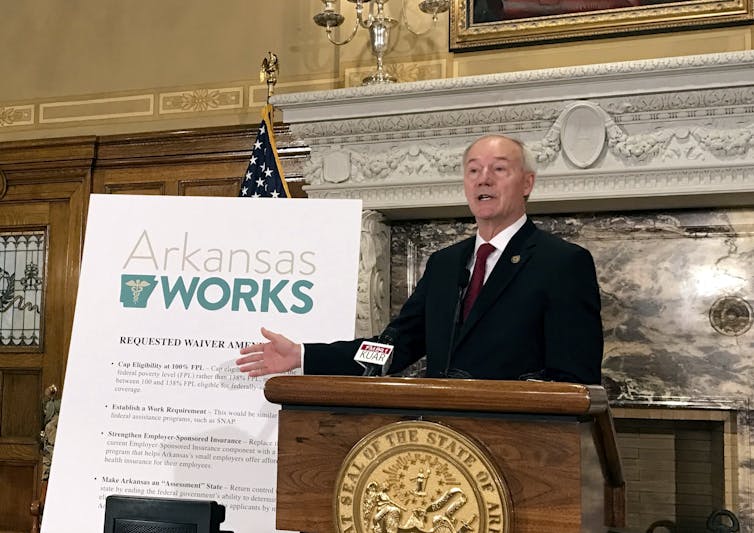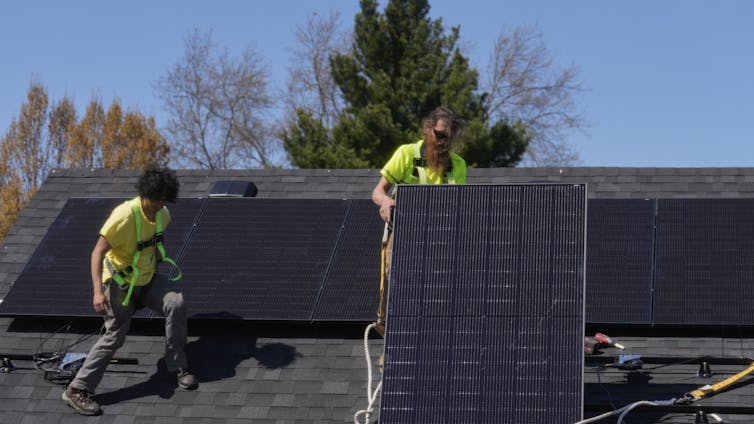
Republican lawmakers have been battling over a bill that includes massive tax and spending cuts. Much of their disagreement has been over provisions intended to reduce the cost of Medicaid.
The popular health insurance program, which is funded by both the federal and state governments, covers about 78.5 million low-income and disabled people – more than 1 in 5 Americans.
On May 22, 2025, the House of Representatives narrowly approved the tax, spending and immigration bill. The legislation, which passed without any support from Democrats, is designed to reduce federal Medicaid spending by requiring anyone enrolled in the program who appears to be able to get a job to either satisfy work requirements or lose their coverage. It’s still unclear, however, whether Senate Republicans would support that provision.
Although there are few precedents for such a mandate for Medicaid, other safety net programs have been enforcing similar rules for nearly three decades. I’m a political scientist who has extensively studied the work requirements of another safety net program: Temporary Assistance for Needy Families.
As I explain in my book, “Living Off the Government? Race, Gender, and the Politics of Welfare,” work requirements place extra burdens on low-income families but do little to lift them out of poverty.
Work requirements for TANF
TANF gives families with very low incomes some cash they can spend on housing, food, clothing or whatever they need most. The Clinton administration launched it as a replacement for a similar program, Aid to Families with Dependent Children, in 1996. At the time, both political parties were eager to end a welfare system they believed was riddled with abuse. A big goal with TANF was ending the dependence of people getting cash benefits on the government by moving them from welfare to work.
Many people were removed from the welfare rolls, but not because work requirements led to economic prosperity. Instead, they had trouble navigating the bureaucratic demands.
TANF is administered by the states. They can set many rules of their own, but they must comply with an important federal requirement: Adult recipients have to work or engage in an authorized alternative activity for at least 30 hours per week. The number of weekly hours is only 20 if the recipient is caring for a child under the age of 6.
The dozen activities or so that can count toward this quota range from participating in job training programs to engaging in community service.
Some adults enrolled in TANF are exempt from work requirements, depending on their state’s own policies. The most common exemptions are for people who are ill, have a disability or are over age 60.
To qualify for TANF, families must have dependent children; in some states pregnant women also qualify. Income limits are set by the state and range from US$307 a month for a family of three in Alabama to $2,935 a month for a family of three in Minnesota.
Adult TANF recipients face a federal five-year lifetime limit on benefits. States can adopt shorter time limits; Arizona’s is 12 months.
An administrative burden
Complying with these work requirements generally means proving that you’re working or making the case that you should be exempt from this mandate. This places what’s known as an “administrative burden” on the people who get cash assistance. It often requires lots of documentation and time. If you have an unpredictable work schedule, inconsistent access to child care or obligations to care for an older relative, this paperwork is hard to deal with.
What counts as work, how many hours must be completed and who is exempt from these requirements often comes down to a caseworker’s discretion. Social science research shows that this discretion is not equally applied and is often informed by stereotypes.
The number of people getting cash assistance has fallen sharply since TANF replaced Aid to Families with Dependent Children. In some states caseloads have dropped by more than 50% despite significant population growth.
Some of this decline happened because recipients got jobs that paid them too much to qualify. The Congressional Budget Office, a nonpartisan office that provides economic research to Congress, attributes, at least in part, an increase in employment among less-educated single mothers in the 1990s to work requirements.
Not everyone who stopped getting cash benefits through TANF wound up employed, however. Other recipients who did not meet requirements fell into deep poverty.
Regardless of why people leave the program, when fewer low-income Americans get TANF benefits, the government spends less money on cash assistance. Federal funding has remained flat at $16.5 billion since 1996. Taking inflation into account, the program receives half as much funding as when it was created. In addition, states have used the flexibility granted them to direct most of their TANF funds to priorities other than cash benefits, such as pre-K education.
Many Americans who get help paying for groceries through the Supplemental Nutrition Assistance Program are also subject to work requirements. People the government calls “able-bodied adults without dependents” can only receive SNAP benefits for three months within a three-year period if they are not employed.
A failed experiment in Arkansas
Lawmakers in Congress and in statehouses have debated whether to add work requirements for Medicaid before. More than a dozen states have applied for waivers that would let them give it a try.
When Arkansas instituted Medicaid work requirements in 2018, during the first Trump administration, it was largely seen as a failure. Some 18,000 people lost their health care coverage, but employment rates did not increase.
After a court order stopped the policy in 2019, most people regained their coverage.
Georgia is currently the only state with Medicaid work requirements in effect, after implementing a waiver in July 2023. The program has experienced technical difficulties and has had trouble verifying work activities.
Other states, including Idaho, Indiana and Kentucky, are already asking the federal government to let them enforce Medicaid work requirements.

What this may mean for Medicaid
The multitrillion-dollar bill the House passed 215-214 would introduce Medicaid work requirements nationwide by late 2026 for childless adults age 19 to 64, with some exemptions.
But most people covered by Medicaid in that age range are already working, and those who are not would likely be eligible for work requirement waivers. An analysis by KFF – a nonprofit that informs the public about health issues – shows that in 2023, 44% of Medicaid recipients were working full time and another 20% were working part time. In 2023, that was more than 16 million Americans.
About 20% of the American adults under 65 who are covered by Medicaid are not working due to illness or disability, or because of caregiving responsibilities, according to KFF. This includes both people caring for young children and those taking care of relatives with an illness or disability. In my own research, I read testimony from families seeking work exemptions because caregiving, including for children with disabilities, was a full-time job.
The rest of the adults under 65 with Medicaid coverage are not working because they are in school, are retired, cannot find work or have some other reason. It’s approximately 3.9 million Americans. Depending on what counts as “work,” they may be meeting any requirements that could be added to the program.
The Congressional Budget Office estimates that introducing Medicaid work requirements would save around $300 billion over a decade. Given past experience with work requirements, it is unlikely those savings would come from Americans finding jobs.
My research suggests it’s more likely that the government would trim spending by taking away the health insurance of people eligible for Medicaid coverage who get tangled up in red tape.
This article was updated on May 22, 2025, with details about the House of Representatives’ passage of the budget bill.![]()
Anne Whitesell, Assistant Professor of Political Science, Miami University
This article is republished from The Conversation under a Creative Commons license. Read the original article.

 How to resolve AdBlock issue?
How to resolve AdBlock issue? 


















